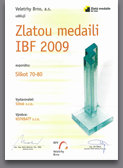Silkot 70-80
machine CHARAcTERISTIcs:
The SILKOT 70-80 machine has been designed for repairing potholes and other defects of asphalt roadways.
Advantages of our TECHNOLOGy:
- The main advantage of this technology is the usage of waste from asphalt roadway milling – recycled material. In the insulated warming-up container the recycled material is warmed-up to 150-160°C without burning and thus deteriorating old asphalt. The recycled material warmed-up in this way is reused in our process and the quality of it is approximately the same as that of the bitumen of the roadway to be repaired.
- The method can be successfully applied also in winter period with frosts up to -10°C (below this value the cost for repairs increases enormously).
- The machine is easy to operate and repairs are easy to carry out.
- The machine is operated by only two trained workers.
- Repaired potholes do not crack further.
- The price of repair is 2-2.5 times lower in comparison with the technologies currently used
- Problematic waste is disposed by means of recycled material usage.
- LPG refuelling is possible at any filling station appropriately equipped.
The technology used by the SILKOT 70-80 machine provides a completely new method of asphalt roadway repairs giving new the repaired roadway new parameters in usability and thus prolonging the roadway surface life at least by 3 to 5 years.
Machine description:
The basic and most important parts of the machine are the insulated heated hopper for approx. 1.1m3 of recycled material and the rear fold-down warming-up face. Other design features are the biaxial chassis with a fold-down ramp for the roller, the winch with a supporting structure for folding-down the rear face, the gas system with three LPG tanks, the electric system with a battery, charging supply and operating boxes with controls securing the machine run.
The machine has been certified by the Ministry of Transport of the Czech Republic and the Engineering Test Institute, s.p. in Brno.
